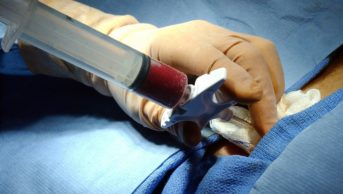
Mclean/Shutterstock.com
In April 2020, there were 5,414 patients on the waiting list for a life-saving or life-enhancing organ transplant[1]
. Between April 2018 and March 2019, 400 patients on this list died waiting for an organ[2]
.
The law around organ donation in England changed to an ‘opt-out’ system on 20 May 2020 and will change to ‘a deemed authorisation system’ in Scotland in March 2021 (see Box 1)[3],[4]
. Under each of these systems, unless a person’s decision to not donate has been recorded, or the individual is from an excluded group, it will be considered that they have agreed to be an organ donor when they die[3],[4],[5]
.
These changes are intended to increase the number of donor organs available in England and Scotland, and to save and improve the lives of patients on transplant waiting lists[3]
. Wales currently operates an opt-out system, which has boosted consent rates for donation after brain stem death and circulatory death by 18.8%, with consent rates now at 77%[5],[6],[7]
.
Patients undergoing multi-organ transplant and those whose previous transplant may have failed — and who, therefore, require another organ — along with increasing comorbidities and polypharmacy, present complex medicines management issues. Pharmacists are involved in the care of transplant recipients at every stage of the transplant pathway, from pre-transplant assessment to post-transplant care, and in the management of their medicines and conditions in the months and years that follow.
Box 1: Changes to the law on organ donation in England
Named after Max Johnson — a young boy whose family campaigned for organ donation prior to him receiving his life-saving heart transplant, and his donor Keira Ball — ‘Max and Keira’s Law’ was enacted in England on 20 May 2020[3],[8]
.
From this date onwards, all adults aged 18 years and older who have lived in England for more than 12 months will automatically be considered as consenting to organ donation.
The change to an ‘opt-out’ system is applicable for people who are able to understand the new arrangements and can take necessary action if their choice is to not remain on the organ donation register.
When organ donation becomes a possibility, healthcare professionals will still consult the NHS Organ Donation Register to see if a patient has ‘opted out’, before consulting with the patient’s family or next of kin, who will need to support this decision. Members of the public can also still actively sign up for organ donation, which allows them to specify the organs they wish to donate and nominate a representative that can pass on their wishes[9],[10]
.
Although consent rates are increasing from donors of a black, Asian and minority ethnic (BAME) background, it is also hoped that the new opt-out system, along with work currently being undertaken by NHS Blood and Transplant and the National BAME Transplant Alliance— focusing on community education, faith and cultural engagement, as well as targeted awareness campaigns — will help further improve these numbers and ensure more patients from a BAME background receive life-saving transplants[11]
.
The NHS Blood and Transplant website provides information that may help pharmacists and pharmacy teams answer questions from patients about organ donation, as well as promotional materials, including posters and social media content that can be downloaded or ordered, as required.
Pharmacy teams in community and general practice can display and promote these materials to encourage more patients to have the necessary discussions with their families about their wishes around organ donation. Organ donation week, which will be held on 3–9 September 2020, presents a further opportunity to raise awareness.
Transplant recipients
Between April 2019 and March 2020, 4,733 patients in the UK received a transplant, including: 3,235 kidney; 167 kidney and pancreas islets; 172 heart; 155 lung; 925 liver; and 20 intestinal transplants[1]
. Allocation of these organs can depend on several factors, ranging from tissue typing between the organ donor and recipient in kidney transplants, to blood group compatibility for liver, lung and heart transplants. Organ size and length of recipient time on the waiting list can also play an important part in allocating a donor organ to a recipient, with each organ’s waiting list having its own criteria on who receives a specific transplant when a potential donor becomes available[12]
.
Success rates for both graft (i.e. the transplanted organ) and patient survival after transplantation are increasing, with predicted short- and long-term survival rates outlined in Table 1.
| Organ | Short-term at one year for organ transplants after donor circulatory death | Long-term for organ transplants after donor brain stem death |
|---|---|---|
| Kidney | 93–95% graft survival 97% patient survival | 86–87% graft survival 86–88% patient survival at 5 years |
| Liver | 94–95% patient survival | 79–83% patient survival at 5 years |
| Pancreas and kidney | 87–89% graft survival 97–99% patient survival | 81% graft survival 87–97% patient survival at 3 years |
| Heart | 83% patient survival | 72% patient survival at 5 years |
| Lung | 81% patient survival | 57% patient survival at 5 years |
| Intestine | 79% patient survival | 63% patient survival at 3 years |
| Source: NHS Blood and Transplant[13] | ||
Considerations before and after transplant
Before a patient can be added to the organ transplant waiting list, they must undergo a thorough assessment to establish that they meet the following criteria:
- Have clear indications for transplant;
- Are well enough to survive the operation;
- Do not have any other significant comorbidities that will limit graft and patient survival. These criteria will vary depending on the organ type[14]
.
Pharmacists managing patients that are being assessed for transplant, and those on the transplant waiting list, must review medicines and comorbidities to ensure appropriate post-transplant management plans are in place. This may include anticipating interactions with immunosuppressant medicines that will be prescribed or ensuring there are clear plans for patients with dysphagia (swallowing problems) or altered gastrointestinal absorption.
Common interactions with calcineurin inhibitors
The calcineurin inhibitors (CNIs), tacrolimus and ciclosporin, both metabolised by the enzyme CYP3A4 and P-glycoprotein, are the first-line immunosuppressant medications used to prevent organ rejection[15]
. Drug–drug interactions can lead to significant changes in blood plasma levels and mainly occur when medicines that are either inducers or inhibitors of the enzyme cytochrome P450 3A4 (CYP3A4) are prescribed (see Table 2).
For patients prescribed tacrolimus and ciclosporin, pharmacists should check for potential drug–drug interactions with all medicines that the patient is prescribed. If a medicine has the potential to interact — for example, antiepileptic medicines or antibiotics — the patient’s transplant team must be notified so that appropriate management advice can be given (e.g. altering CNI dose or advising on monitoring requirements). Patients should be advised to avoid grapefruit juice as it is an intestinal CYP3A4 inhibitor and, therefore, increases CNI levels.
| Drug or drug class | Mechanism of interactions | Effect on plasma calcineurin inhibitor levels |
|---|---|---|
| Clarithromycin and erythromycin | CYP3A4 inhibitor | Increased levels |
| Imidazole antifungals | CYP3A4 inhibitor | Increased levels |
| Diltiazem/verapamil | CYP3A4 inhibitor | Increased levels |
| Phenytoin | CYP3A4 inducer | Decreased levels |
| Carbamazepine | CYP3A4 inducer | Decreased levels |
| Rifampicin | CYP3A4 inducer | Decreased levels |
| Non-steroidal anti-inflammatory drugs | Multifactorial, inhibits p-glycoprotein and competes for plasma binding | Increased levels |
| Source: MedicinesComplete[16] | ||
Immediate post-transplant considerations
By this stage, patients will have undergone complex surgery and will be taking a number of high-risk medicines, in addition to being at risk of complications (e.g. early rejection of the transplanted organ, post-operative infections and clotting issues or renal dysfunction).
Medication counselling ensures the patient has the best possible chance of managing their newly prescribed immunosuppression and associated transplant medicines at home. Patients should be advised on when to take their prescribed medicine, any specific administration requirements and what to do if they forget or are unable to take their medicines. Patients will have a point of contact who they can contact if issues arise — this will vary between transplant centres.
As with any medicines, immunosuppressant medications can have significant side effects and patients should be counselled about these, so that any issues can be discussed with the transplant team (see Table 3). If a worried patient asks pharmacists or a member of the pharmacy team about a possible side effect of their immunosuppression, or if they are showing signs or symptoms of these, the transplant team must be alerted before any medicine is changed.
An increasing number of brands of immunosuppressant medicines are available; however, brands are not always interchangeable owing to varying bioequivalence. Pharmacists should, therefore, ensure brands are not inadvertently switched as this can lead to variations in the blood level, which can impact graft function[17]
.
| Drug or drug class | Side effect | Frequency of occurrence* |
|---|---|---|
| Calcineurin inhibitors (e.g. tacrolimus and ciclosporin) | Hypertension | Very common |
| Impaired glucose tolerance (post-transplant diabetes mellitus) | Very common (tacrolimus), common (ciclosporin) | |
| Tremors and headaches | Very common | |
| Hyperlipidaemia | Very common (ciclosporin), common (tacrolimus) | |
| Nephrotoxicity | Very common | |
| Electrolyte abnormalities | Common | |
| Tacrolimus | Alopecia | Common |
| Ciclosporin | Hirsutism | Very common |
| Gingival hyperplasia | Common | |
| Mycophenolate mofetil (antimetabolite) | Gastrointestinal disturbances | Very common |
| Atypical infections | Common | |
| Leukopenia | Very common | |
| Azathioprine (antimetabolite) | Leukopenia | Very common |
| Sirolimus (mammalian target of rapamycin inhibitor | Delayed wound healing | Very common |
| Gastrointestinal disturbances | Very common | |
| Stomatitis | Common | |
| Impaired glucose tolerance (post-transplant diabetes mellitus) | Very common | |
| Acne | Very common | |
| Hyperlipidaemia | Very common | |
| *Very common is a frequency greater than 1 in 10; common is a frequency between 1 in 100 to 1 in 10. Sources: British National Formulary [18],[19],[20],[21],[22] | ||
Ongoing management of transplant recipients
Transplant pharmacists are increasingly providing input to outpatient care, with their main responsibility being to manage medicines and their side effects. Increasing numbers of transplant centres are introducing a pharmacist service to the outpatient setting.
Transplant pharmacists should:
- Assist patients if there are supply issues with their medicines by liaising with community pharmacies to assist in obtaining supplies (e.g. for Advagraf [tacrolimus; Astellas Pharma], which must be ordered directly from the manufacturer) or ensuring ongoing supplies of medications if there is a shortage;
- Liaise with community pharmacies and GP practices to ensure continuity of care;
- Answer queries from doctors who are reviewing patients in the clinic;
- Adjust doses of medicines and immunosuppressing agents based on changes in renal function;
- Refer patients for review as appropriate;
- Ensure that medicines with a defined course length are stopped as appropriate (e.g. valganciclovir, which is used for prophylaxis and treatment of cytomegalovirus infections, is required for a defined length of time and can cause significant side effects, including nephrotoxicity and neutropenia).
- Answer any questions the patient may have and address concerns about their medicines. Often these will be about side effects, with hair loss associated with tacrolimus use being a common concern. Questions about interactions with over-the-counter medicines are also common;
- Advise patients on precautions for travel and the suitability of travel vaccines, and malaria prophylaxis as needed. Patients can be advised to attend their local travel health clinic or speak to a community pharmacist to get destination-specific advice about requirements. However, it is recommended that they check with their transplant pharmacist about any potential interactions with their immunosuppressant medications and potential alternative options available to them. Patients on immunosuppressants should be advised to use a high-factor sun cream as they are at an increased risk of skin cancer and some immunosuppressants can cause photosensitivity;
- During the COVID-19 pandemic, it is essential for patients taking post-transplant immunosuppressive medicines to rigorously follow shielding measures as they are at the greatest risk of severe illness and infection;
- Advise patients on contraception, and answer queries about the use of medications during pregnancy and breastfeeding in the post-transplant population. Transplant patients can become pregnant, but it is essential that the transplant team is involved from the planning stage to ensure the patient is as healthy as possible and that their medicine regimen is as safe as possible for the baby. There is strict guidance around pregnancy and some common transplant medicines (e.g. mycophenolate) and the pharmacy team should ensure that the patient is aware of the precautions. They should also assist the transplant team in taking the necessary action if a patient wants to start a family[23]
,[24]
,[25]
.
Increasingly, GPs are not able to or have limitations when prescribing immunosuppressive medicines (e.g. tacrolimus and mycophenolate) owing to local prescribing formularies. Therefore, transplant pharmacists should ensure that patients know the arrangement for ongoing supply of their medicines. Arrangements differ between settings (e.g. homecare, outpatient pharmacy), but the specialist pharmacist in each setting will be able to assist with issues surrounding supply of immunosuppressive medicines.
Pharmacists can ensure the long-term health of the patient is optimised in the years following a transplant. Owing to their side effect profile calcineurin inhibitors (e.g. tacrolimus and ciclosporin) and sirolimus, the mammalian target of rapamycin inhibitor, increase cardiovascular health risks (see Table 3). Therefore, ongoing monitoring and management of high blood pressure and cholesterol, with either their GP or specialist clinic, is important[18],[19],
[22]
. These medicines, along with steroids, which are commonplace after a transplant, can also increase blood glucose and cause a type of diabetes known as post-transplant diabetes mellitus. Patients should be advised on how to maintain a healthy lifestyle (e.g. exercise, diet and maintaining a healthy weight), as appropriate and in line with their post-transplant recovery.
References
[1] NHS Blood and Transplant. Organ Donation and Transplantation — Activity figures for the UK as at 9 April 2020. 2020. Available at: https://nhsbtdbe.blob.core.windows.net/umbraco-assets-corp/18279/annual_stats.pdf (accessed May 2020)
[2] NHS Blood and Transplant. Transplant activity report section 1 — Summary of Transplant Activity. 2019. Available at: https://www.organdonation.nhs.uk/helping-you-to-decide/about-organ-donation/statistics-about-organ-donation/transplant-activity-report/ (accessed May 2020)
[3] NHS Blood and Transplant. Organ donation law in England is changing. 2020. Available at: https://www.organdonation.nhs.uk/uk-laws/organ-donation-law-in-england/ (accessed May 2020)
[4] NHS Blood and Transplant. Organ and tissue donation law in Scotland. 2020. Available at: https://www.organdonation.nhs.uk/uk-laws/organ-donation-law-in-scotland/ (accessed May 2020)
[5] NHS Blood and Transplant. Organ donation law in Wales. 2020. Available at: https://www.organdonation.nhs.uk/uk-laws/organ-donation-law-in-wales/ (accessed May 2020)
[6] NHS Blood and Transplant. Organ Donation and transplantation activity report 2015/2016. 2016. Available at: https://www.odt.nhs.uk/statistics-and-reports/annual-activity-report/ (accessed May 2020)
[7] NHS Blood and Transplant. Transplant activity report section 13 — National potential donor audit. 2019. Available at: https://www.odt.nhs.uk/statistics-and-reports/annual-activity-report/ (accessed May 2020)
[8] NHS Blood and Transplant. Max, heart transplant recipient and campaigner. 2017. Available at: https://www.organdonation.nhs.uk/helping-you-to-decide/real-life-stories/people-who-have-benefitted-from-receiving-a-transplant/max-heart-transplant-recipient-and-campaigner/ (accessed May 2020)
[9] NHS Blood and Transplant. Register your decision. 2020. Available at: https://www.organdonation.nhs.uk/helping-you-to-decide/about-your-choices/ (accessed May 2020)
[10] NHS Blood and Transplant. Nominate a representative. 2020. Available at: https://www.organdonation.nhs.uk/register-your-decision/nominate-a-representative/ (accessed May 2020)
[11] NHS Blood and Transplant. Organ donation and transplantation data for black, Asian and minority ethnic (BAME) communities report for 2018/2019. 2019. Available at: https://www.odt.nhs.uk/statistics-and-reports/annual-activity-report/ (accessed May 2020)
[12] Featherstone B. A rough guide to transplant medicines. Pharm J 2011;287:539-542. Available at: https://www.pharmaceutical-journal.com/files/rps-pjonline/pdf/PJ051111_539-342.pdf (accessed May 2020)
[13] NHS Blood and Transplant. Survival rates following transplantation section 11. 2019. Available at: https://www.organdonation.nhs.uk/helping-you-to-decide/about-organ-donation/statistics-about-organ-donation/transplant-activity-report/ (accessed May 2020)
[14] NHS Inform. Liver transplant. 2020. Available at: https://www.nhsinform.scot/tests-and-treatments/surgical-procedures/liver-transplant (accessed May 2020)
[15] Up to Date. Liver transplantation in adults: Overview of immunosuppression. 2019. Available at: https://www.uptodate.com/contents/liver-transplantation-in-adults-overview-of-immunosuppression (accessed May 2020)
[16] MedicinesComplete. Stockley’s Drug Interactions. 2020. Available at: http://www.new.medicinescomplete.com (accessed May 2020)
[17] Medicines and Healthcare products Regulatory Agency. Oral tacrolimus products: reminder to prescribe and dispense by brand name only. 2017. Available at: https://www.gov.uk/drug-safety-update/oral-tacrolimus-products-reminder-to-prescribe-and-dispense-by-brand-name-only (accessed May 2020)
[18] British National Formulary. Tacrolimus side effects. 2017. Available at: https://bnf.nice.org.uk/drug/tacrolimus.html#sideEffects (accessed May 2020)
[19] British National Formulary. Ciclosporin side effects. 2017. Available at: https://bnf.nice.org.uk/drug/ciclosporin.html#sideEffects (accessed May 2020)
[20] British National Formulary. Mycophenolate mofetil side effects. 2017. Available at: https://bnf.nice.org.uk/drug/mycophenolate-mofetil.html#sideEffects (accessed May 2020)
[21] British National Formulary. Azathioprine side effects. 2017. Available at: https://bnf.nice.org.uk/drug/azathioprine.html#sideEffects (accessed May 2020)
[22] British National Formulary. Sirolimus side effects. 2017. Available at: https://bnf.nice.org.uk/drug/sirolimus.html#sideEffects (accessed May 2020)
[23] eMC. Valcyte 450 mg Film-Coated Tablets. 2018. Available at: https://www.medicines.org.uk/emc/product/1641/smpc#UNDESIRABLE_EFFECTS (accessed May 2020)
[24] UK Government. Guidance on shielding and protecting people who are clinically extremely vulnerable from COVID-19. 2020. Available at: https://www.gov.uk/government/publications/guidance-on-shielding-and-protecting-extremely-vulnerable-persons-from-covid-19/guidance-on-shielding-and-protecting-extremely-vulnerable-persons-from-covid-19 (accessed May 2020)
[25] UK Government. Mycophenolate mofetil, mycophenolic acid: new pregnancy-prevention advice for women and men. 2015. Available at: https://www.gov.uk/drug-safety-update/mycophenolate-mofetil-mycophenolic-acid-new-pregnancy-prevention-advice-for-women-and-men (accessed May 2020)


